Do you have a question about the Pioneer CDJ-400 and is the answer not in the manual?
Warning about internal high voltages and the need for qualified service personnel.
Precautions against water, splashing, rain, and moisture to prevent fire or shock.
Ensure adequate airflow and avoid blocking vents to prevent overheating and fire hazards.
Guidelines for handling the power cord safely and checking for damage.
Describes the Scratch Jog Effect and its associated buttons for new scratch sounds.
Explains Digital Jog Break functions (JET, ROLL, WAH) for creating original sound effects.
Covers Pitch Bend, Scratch Play, Frame Search, and Super-Fast Search functionalities.
Details the tempo slider, adjustment range, and Master Tempo feature.
Explains Reverse Play, Cue functions, and Loop/Reloop features.
Covers Real Time Seamless Loop, Beat Loop/Loop Divide, Playing Address, and Fader Start.
Explains the vibration-resistant construction for stable sound output.
States support for CD-R and CD-RW discs.
Explains playback of MP3 files from CD-ROM or USB using DJ functions.
Describes connecting to a computer for software control and audio output.
Legal disclaimer regarding software trademarks and character sets.
Identifies playable disc formats (CD, CD-TEXT, CD-R, CD-RW) with logos.
Details TEXT display capabilities, character limits, and scrolling behavior.
Explains player support for CD-R/CD-RW discs recorded in audio CD or MP3 format.
Addresses potential playback issues with CD-R/RW discs due to various factors.
States product conforms to music CD standards; performance not guaranteed for other formats.
Details MP3 file formats (CBR/VBR) and technical specifications for playback.
Safe procedure to disconnect USB device using SOURCE SELECT.
Advice on placing the player in a well-ventilated area, away from heat, humidity, and direct sunlight.
Tips to ensure optimal performance by placement away from heat sources, tuners, TVs, and speakers.
How to clean the player with a soft, dry cloth or mild detergent solution.
Advises professional service for pickup lens issues.
Proper methods for storing discs to prevent warping and damage.
Procedures for managing condensation when moving the unit between different temperatures.
Instructions for cleaning discs and proper handling to avoid damage.
Caution against playing non-circular CDs to prevent malfunction.
Details audio and CONTROL connections to DJ mixers like DJM-400, DJM-600, etc.
Explains linking units via control cable for automatic relay playback.
Instructions for connecting to a stereo amplifier's CD or AUX inputs.
How to connect to digital inputs using a digital signal cable.
Guide for USB connection to a computer, including OS and driver info.
Steps for connecting the power cord to the unit and the wall outlet.
Located on the rear panel for turning the unit ON/OFF.
Refers to page 12 for detailed display information.
Returns to the next higher level in the folder hierarchy.
Used to eject the disc.
Describes CUE/LOOP MEMORY/DELETE and CUE/LOOP CALL buttons for managing cue/loop points.
Selects tracks/folders; press to confirm.
Preserves Digital Jog Break and Scratch Jog Effect.
Switches jog dial mode between VINYL and CDJ.
Changes the variable tempo range.
Turns Master Tempo function ON/OFF.
Controls the track's tempo (playback speed).
Refers to page 15 for detailed jog dial functions.
Lights indicate when a disc or USB memory is selected.
Step-by-step guide to customize jog indicator light patterns.
Located on the front panel.
Shows disc insertion status.
For emergency disc ejection.
Used to start and pause playback.
Shows playback status (playing/paused).
Used to set and confirm cue points.
Indicates cue point status.
Controls fast-forward and fast-reverse playback.
Used to change tracks forward or reverse.
Activates reverse playback mode.
Details IN/REALTIME CUE/HOT LOOP, OUT/OUT ADJUST, RELOOP/EXIT, BEAT LOOP/LOOP DIVIDE buttons.
Buttons select effects based on JOG mode.
Choose playback source between USB and CD.
For connecting a USB memory device.
Changes TEXT display and enters utility mode.
Switches time display and toggles AUTO CUE function.
Lights up when jog dial top is pressed in VINYL mode.
Describes the connectors and switches located on the rear of the unit.
For connecting to a computer.
RCA-type analog audio output jacks.
Connects to DJ mixer for fader start play/back cue or to another CD player for relay play.
RCA coaxial digital output for DJ mixers/AV amps.
Connects to the AC power outlet.
Switches the unit's power ON/OFF.
Shows folder number, track number, or alphanumeric data.
Lights when remaining track time is displayed.
Shows time (minutes) or alphanumeric data.
Shows time (seconds) or alphanumeric data.
Shows time (frames) or alphanumeric data.
Displays tempo change rate.
Lights when Master Tempo function is ON.
Lights when TEMPO control range is set to WIDE.
Lights indicate the selected tempo range.
Displays the BPM of the track.
Displays text.
Lights when Auto Cue function is ON.
Shows track playback progress as a full-scale graph.
Lights when a cue/loop point is saved.
Explains how to switch TEXT display modes for CD-TEXT and MP3s.
Press TIME MODE to alternate between elapsed and remaining time.
Instructions on how to remove the jog sheet for replacement.
Step-by-step instructions for inserting a disc with label surface up.
How to cancel an eject command by pressing PLAY/PAUSE.
Procedure for ejecting a disc when the EJECT button fails.
Explains how to turn Auto Cue ON/OFF and change its level.
Instructions for starting playback from disc or USB memory.
Restarts playback from the point where the disc was ejected.
How to stop playback by pressing the EJECT button.
How to pause playback using the PLAY/PAUSE button.
How to change music tempo by rotating the jog dial.
How to perform scratch play by rotating the jog dial.
How to move the pause position in frame units by rotating the jog dial.
Refers to page 17 for cue point adjustment.
Refers to page 15 for Super-Fast search.
Refers to page 15 for Super-Fast track search.
Refers to page 16 for Digital Jog Break.
Refers to page 16 for Scratch Jog Effect.
Using SEARCH buttons for fast-forward/fast-reverse.
Rotating jog dial while pressing SEARCH buttons.
Using TRACK SEARCH buttons to cue tracks.
Rotating jog dial while pressing TRACK SEARCH buttons.
Using the rotary dial to search tracks and folders.
Pressing TEMPO button to cycle through ±6%, ±10%, ±16%, WIDE ranges.
Produces a bubbly sound effect.
Produces a muted sound effect.
Produces a wah-wah effect.
Adds a short delay sound, creating a "swooshing" effect.
Affects pitch and playback time based on jog dial rotation.
Adds a filter with cutoff frequency that changes with jog dial rotation.
Maintains effect after jog dial rotation stops.
Steps to set a cue point by pausing and searching.
Steps to adjust or change an existing cue point.
Covers REALTIME CUE and Back Cue functions.
How to use the CUE button to confirm cue points.
Step-by-step guide to mixing two tracks using a DJ mixer.
Details loop creation, Auto Beat Loop, Loop Divide, HOT LOOP, RELOOP, and exiting loops.
Steps to set loop-in and loop-out points.
How to start loop play with automatically set loop-out point (Auto BEAT LOOP).
Using BEAT LOOP/LOOP DIVIDE buttons to divide loops.
Using IN/REALTIME CUE/HOT LOOP button to restart loop playback (HOT LOOP).
Using RELOOP/EXIT button to exit loop playback.
Steps to adjust the loop-out point.
Using control cable and DJ mixer fader for immediate playback.
How to perform scratch play by rotating the jog dial in VINYL mode.
How to perform spin play in VINYL mode.
How to activate reverse playback.
How to record a cue point using Auto Cue or CUE button.
How to record loop-in and loop-out points.
How to recall saved cue/loop points using CUE/LOOP CALL.
How to delete memorized cue/loop points using MEMORY/DELETE.
Important notes regarding relay play operation and mixer connections.
Steps to write cue/loop point data to USB.
Steps to read cue/loop point data from USB.
How to set and save the MIDI channel (1 to 16).
Symptoms, causes, and remedies for disc not ejecting.
Symptoms, causes, and remedies for playback not starting or stopping.
Causes and remedies for inability to play or search MP3 files.
Causes and remedies for no sound or distorted sound.
Causes and remedies for noise or playback stoppage with certain discs.
Cause and remedy when track search is not finished with Auto Cue ON.
Cause and remedy when back cue function does not work.
Cause and remedy when OUT/OUT ADJUST doesn't start loop play.
Cause and remedy when jog dial does not operate as desired.
Cause and remedy for TV picture fluctuation or FM interference.
Cause and remedy when disc does not rotate when power is ON.
Lists error codes, types, descriptions, and possible causes/actions.
Covers system, power requirements, consumption, operating temp/humidity, weight, and dimensions.
Details frequency response, signal-to-noise ratio, and distortion.
Lists included accessories like manual, power cord, audio cable, etc.
States specifications and design are subject to change.
Warning about internal high voltages and the need for qualified service personnel.
Precautions against water, splashing, rain, and moisture to prevent fire or shock.
Ensure adequate airflow and avoid blocking vents to prevent overheating and fire hazards.
Guidelines for handling the power cord safely and checking for damage.
Describes the Scratch Jog Effect and its associated buttons for new scratch sounds.
Explains Digital Jog Break functions (JET, ROLL, WAH) for creating original sound effects.
Covers Pitch Bend, Scratch Play, Frame Search, and Super-Fast Search functionalities.
Details the tempo slider, adjustment range, and Master Tempo feature.
Explains Reverse Play, Cue functions, and Loop/Reloop features.
Covers Real Time Seamless Loop, Beat Loop/Loop Divide, Playing Address, and Fader Start.
Explains the vibration-resistant construction for stable sound output.
States support for CD-R and CD-RW discs.
Explains playback of MP3 files from CD-ROM or USB using DJ functions.
Describes connecting to a computer for software control and audio output.
Legal disclaimer regarding software trademarks and character sets.
Identifies playable disc formats (CD, CD-TEXT, CD-R, CD-RW) with logos.
Details TEXT display capabilities, character limits, and scrolling behavior.
Explains player support for CD-R/CD-RW discs recorded in audio CD or MP3 format.
Addresses potential playback issues with CD-R/RW discs due to various factors.
States product conforms to music CD standards; performance not guaranteed for other formats.
Details MP3 file formats (CBR/VBR) and technical specifications for playback.
Safe procedure to disconnect USB device using SOURCE SELECT.
Advice on placing the player in a well-ventilated area, away from heat, humidity, and direct sunlight.
Tips to ensure optimal performance by placement away from heat sources, tuners, TVs, and speakers.
How to clean the player with a soft, dry cloth or mild detergent solution.
Advises professional service for pickup lens issues.
Proper methods for storing discs to prevent warping and damage.
Procedures for managing condensation when moving the unit between different temperatures.
Instructions for cleaning discs and proper handling to avoid damage.
Caution against playing non-circular CDs to prevent malfunction.
Details audio and CONTROL connections to DJ mixers like DJM-400, DJM-600, etc.
Explains linking units via control cable for automatic relay playback.
Instructions for connecting to a stereo amplifier's CD or AUX inputs.
How to connect to digital inputs using a digital signal cable.
Guide for USB connection to a computer, including OS and driver info.
Steps for connecting the power cord to the unit and the wall outlet.
Located on the rear panel for turning the unit ON/OFF.
Refers to page 12 for detailed display information.
Returns to the next higher level in the folder hierarchy.
Used to eject the disc.
Describes CUE/LOOP MEMORY/DELETE and CUE/LOOP CALL buttons for managing cue/loop points.
Selects tracks/folders; press to confirm.
Preserves Digital Jog Break and Scratch Jog Effect.
Switches jog dial mode between VINYL and CDJ.
Changes the variable tempo range.
Turns Master Tempo function ON/OFF.
Controls the track's tempo (playback speed).
Refers to page 15 for detailed jog dial functions.
Lights indicate when a disc or USB memory is selected.
Step-by-step guide to customize jog indicator light patterns.
Located on the front panel.
Shows disc insertion status.
For emergency disc ejection.
Used to start and pause playback.
Shows playback status (playing/paused).
Used to set and confirm cue points.
Indicates cue point status.
Controls fast-forward and fast-reverse playback.
Used to change tracks forward or reverse.
Activates reverse playback mode.
Details IN/REALTIME CUE/HOT LOOP, OUT/OUT ADJUST, RELOOP/EXIT, BEAT LOOP/LOOP DIVIDE buttons.
Buttons select effects based on JOG mode.
Choose playback source between USB and CD.
For connecting a USB memory device.
Changes TEXT display and enters utility mode.
Switches time display and toggles AUTO CUE function.
Lights up when jog dial top is pressed in VINYL mode.
Describes the connectors and switches located on the rear of the unit.
For connecting to a computer.
RCA-type analog audio output jacks.
Connects to DJ mixer for fader start play/back cue or to another CD player for relay play.
RCA coaxial digital output for DJ mixers/AV amps.
Connects to the AC power outlet.
Switches the unit's power ON/OFF.
Shows folder number, track number, or alphanumeric data.
Lights when remaining track time is displayed.
Shows time (minutes) or alphanumeric data.
Shows time (seconds) or alphanumeric data.
Shows time (frames) or alphanumeric data.
Displays tempo change rate.
Lights when Master Tempo function is ON.
Lights when TEMPO control range is set to WIDE.
Lights indicate the selected tempo range.
Displays the BPM of the track.
Displays text.
Lights when Auto Cue function is ON.
Shows track playback progress as a full-scale graph.
Lights when a cue/loop point is saved.
Explains how to switch TEXT display modes for CD-TEXT and MP3s.
Press TIME MODE to alternate between elapsed and remaining time.
Instructions on how to remove the jog sheet for replacement.
Step-by-step instructions for inserting a disc with label surface up.
How to cancel an eject command by pressing PLAY/PAUSE.
Procedure for ejecting a disc when the EJECT button fails.
Explains how to turn Auto Cue ON/OFF and change its level.
Instructions for starting playback from disc or USB memory.
Restarts playback from the point where the disc was ejected.
How to stop playback by pressing the EJECT button.
How to pause playback using the PLAY/PAUSE button.
How to change music tempo by rotating the jog dial.
How to perform scratch play by rotating the jog dial.
How to move the pause position in frame units by rotating the jog dial.
Refers to page 17 for cue point adjustment.
Refers to page 15 for Super-Fast search.
Refers to page 15 for Super-Fast track search.
Refers to page 16 for Digital Jog Break.
Refers to page 16 for Scratch Jog Effect.
Using SEARCH buttons for fast-forward/fast-reverse.
Rotating jog dial while pressing SEARCH buttons.
Using TRACK SEARCH buttons to cue tracks.
Rotating jog dial while pressing TRACK SEARCH buttons.
Using the rotary dial to search tracks and folders.
Pressing TEMPO button to cycle through ±6%, ±10%, ±16%, WIDE ranges.
Produces a bubbly sound effect.
Produces a muted sound effect.
Produces a wah-wah effect.
Adds a short delay sound, creating a "swooshing" effect.
Affects pitch and playback time based on jog dial rotation.
Adds a filter with cutoff frequency that changes with jog dial rotation.
Maintains effect after jog dial rotation stops.
Steps to set a cue point by pausing and searching.
Steps to adjust or change an existing cue point.
Covers REALTIME CUE and Back Cue functions.
How to use the CUE button to confirm cue points.
Step-by-step guide to mixing two tracks using a DJ mixer.
Details loop creation, Auto Beat Loop, Loop Divide, HOT LOOP, RELOOP, and exiting loops.
Steps to set loop-in and loop-out points.
How to start loop play with automatically set loop-out point (Auto BEAT LOOP).
Using BEAT LOOP/LOOP DIVIDE buttons to divide loops.
Using IN/REALTIME CUE/HOT LOOP button to restart loop playback (HOT LOOP).
Using RELOOP/EXIT button to exit loop playback.
Steps to adjust the loop-out point.
Using control cable and DJ mixer fader for immediate playback.
How to perform scratch play by rotating the jog dial in VINYL mode.
How to perform spin play in VINYL mode.
How to activate reverse playback.
How to record a cue point using Auto Cue or CUE button.
How to record loop-in and loop-out points.
How to recall saved cue/loop points using CUE/LOOP CALL.
How to delete memorized cue/loop points using MEMORY/DELETE.
Important notes regarding relay play operation and mixer connections.
Steps to write cue/loop point data to USB.
Steps to read cue/loop point data from USB.
How to set and save the MIDI channel (1 to 16).
Symptoms, causes, and remedies for disc not ejecting.
Symptoms, causes, and remedies for playback not starting or stopping.
Causes and remedies for inability to play or search MP3 files.
Causes and remedies for no sound or distorted sound.
Causes and remedies for noise or playback stoppage with certain discs.
Cause and remedy when track search is not finished with Auto Cue ON.
Cause and remedy when back cue function does not work.
Cause and remedy when OUT/OUT ADJUST doesn't start loop play.
Cause and remedy when jog dial does not operate as desired.
Cause and remedy for TV picture fluctuation or FM interference.
Cause and remedy when disc does not rotate when power is ON.
Lists error codes, types, descriptions, and possible causes/actions.
Covers system, power requirements, consumption, operating temp/humidity, weight, and dimensions.
Details frequency response, signal-to-noise ratio, and distortion.
Lists included accessories like manual, power cord, audio cable, etc.
States specifications and design are subject to change.
| Frequency range | 4 - 20000 Hz |
|---|---|
| Signal-to-Noise Ratio (SNR) | 115 dB |
| Total Harmonic Distortion (THD) | 0.006 % |
| CD-RW playback | Yes |
| Media types supported | CD, CD-R, CD-RW, MP3 CD |
| Device type | Portable CD player |
| Display type | - |
| Power requirements | 220 - 240 V, 50/60 Hz |
| Power consumption (typical) | 19 W |
| Dimensions (WxDxH) | 217.9 x 296.3 x 107.5 mm |
| Weight | 2700 g |
|---|
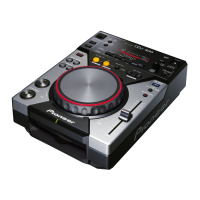

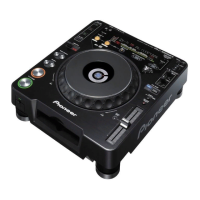
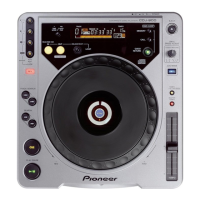
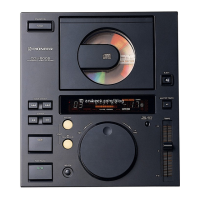
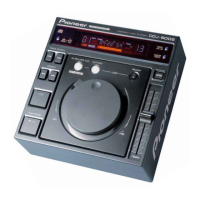
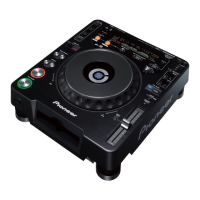

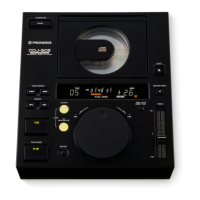


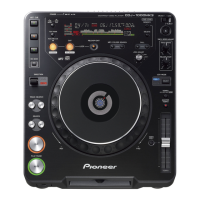
